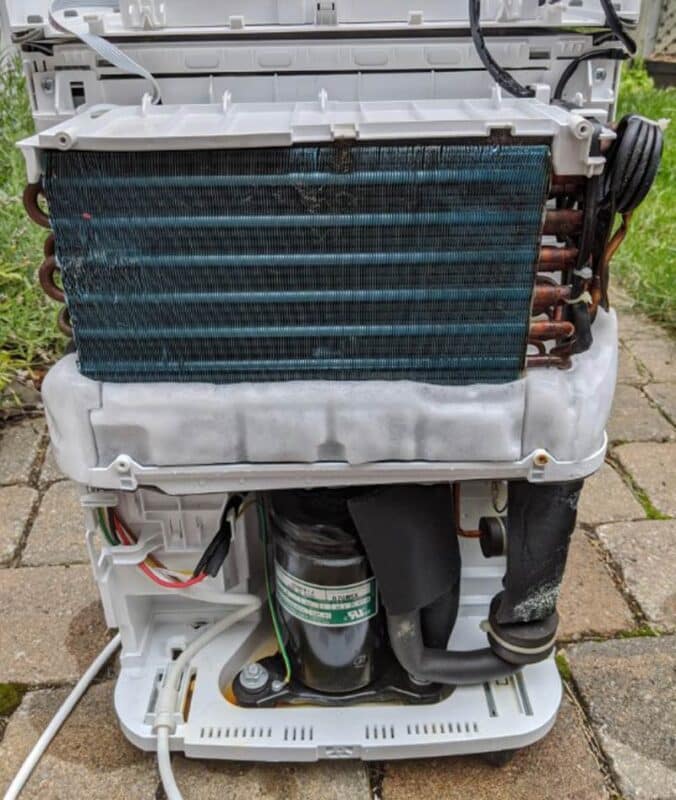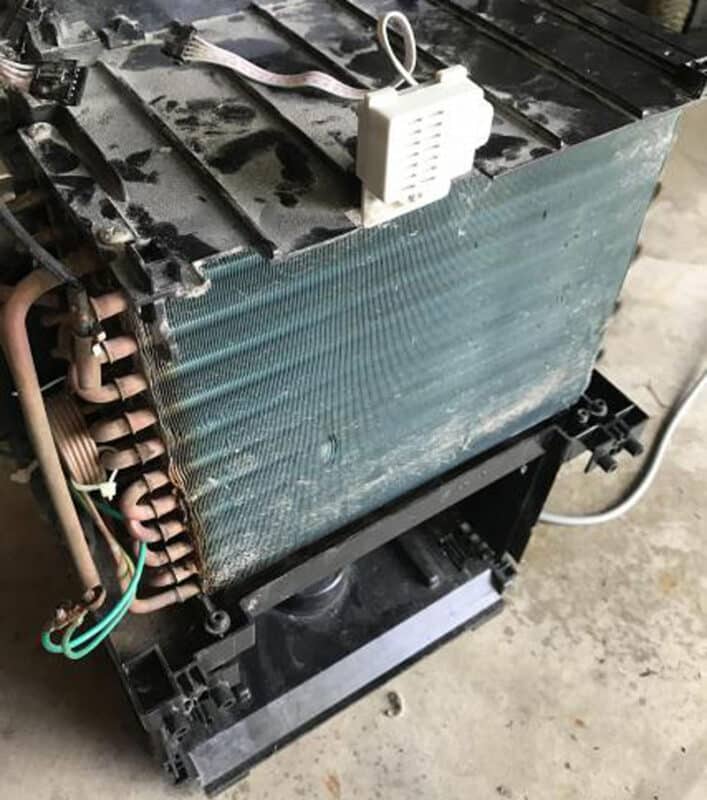Is your Dehumidifier trying to evolve into a freezer?
Dehumidifiers are fantastic for making us more comfortable, but some can get stuck in a cycle of freezing their water rather than just drying their air.
If your Dehumidifier is freezing up and you’re looking for answers, you have come to the right place. In this article, we’re covering 5 simple steps to fix a dehumidifier that’s freezing up.
To fix a frozen dehumidifier, ensure your humidistat is functioning properly, replace the Dehumidifier’s filter, and clean the coils. In addition, try increasing the room temperature before you turn on your Dehumidifier to stop the freezing cycle from starting.
That’s the short answer, but a few details are important to know.
Below, I’ve prepared a list of the most common causes behind a dehumidifier that’s freezing up and the simplest steps you can take to address each one of them. There’s no doubt in my mind that if you follow them to a tee, you’ll be able to thaw out your Dehumidifier faster than you can say, “Let it Go!“.
Let’s get defrosting!
Fixing a Dehumidifier That’s Freezing Up
#1 Increase the Room Temperature
If your Dehumidifier is freezing up, it’s likely because you’re not sticking to your manufacturer’s minimum recommended operating temperatures.
Most manufacturers advise against using dehumidifiers in areas below 60 degrees Fahrenheit, and there’s a good reason for that. As you probably know, your unit has two coils. One runs hot, and one runs cold.
The cold coil condenses the air sucked into the unit and removes the excessive moisture, while the hot coil warms the air up and releases a drier current into your living spaces.
When the Dehumidifier is used under the 60 °F temperature threshold, the cold coil can freeze and create many problems.
Solution: Try to increase your room’s temperature before using your Dehumidifier whenever possible.
If the cold coil has already frozen up, wait for it to thaw out, and then gain comfortable access to it by carefully unplugging your Dehumidifier and removing the frontal plastic panel, the filter, and the protective screws behind them.
Once you have clear access to the coils, use a clean rag to remove any dust or remaining ice. I often tell homeowners to try to clean their dehumidifier coils at least once every two months.

#2 Check the Humidistat
Another possible reason why your Dehumidifier is freezing up is a faulty humidistat.
If you’re unfamiliar with what the humidistat component does, it’s fairly simple. Your humidistat is solely responsible for measuring the humidity levels in a specific area and regulating the machine’s processes accordingly.
When the humidistat works normally, it should accept and follow your every input, giving you no trouble. However, when it malfunctions, it could prompt the unit to work harder than it has to, thus contributing to excessive coil cooling and eventual freezing.
If your Dehumidifier keeps freezing up, there’s a very good chance that you have to replace the humidistat immediately.
Solution: If you followed the steps from the previous point and cleaned your coils, your internal components are already exposed.
Look closely and try to identify your humidistat. It should be located behind the water reservoir, although its location may vary from model to model. Once you have found it, gain comfortable access to it and use a multimeter to test it for continuity.
You’ll have to buy a replacement if you get null readings on the meter. But don’t worry; you can easily get one from your nearest hardware store or by contacting your manufacturer.
If you want to get any replacement part – or see how much one would cost – click to enter your model number in the search bar below. Our partners at AppliancePartsPros stock almost every part with free guides on how to install them.

#3 Replace the Fan Motor
A faulty fan motor could also explain why your Dehumidifier is freezing up.
When the motor is working normally, it allows your fan to spin and pull in the air from the environment while promoting the adequate distribution of it throughout your unit’s components.
However, when the motor malfunctions, its ability to create proper airflow is severely compromised, resulting in iced-up coils, improper water collection, and even overheating.
A dehumidifier motor failure is similar to what happens when a water cooler’s compressor breaks, as the liquid is exposed to the refrigerant for too long, resulting in frozen water.
It is of the utmost importance that you check and replace the fan motor if you suspect it to be the source of your problem. From what I’ve seen, putting the replacement off for too long can cause permanent damage to your Dehumidifier.
Solution: Look through your internal components and locate your fan motor; it should sit right behind the fan blades and the bearing. Test the fan motor for continuity and replace it if necessary.
#4 Replace the Filter
Not giving your air filters enough attention could also explain why your Dehumidifier keeps freezing up.
How so?
The filter is the only thing that stands between the outside world’s pollutants and your Dehumidifier’s internal components. Without the filter, any debris or harmful particles in the air could reach your appliance’s guts and wreak havoc.
Being the filter such an essential part of your Dehumidifier, it should be no surprise that airflow is compromised when it becomes excessively dirty or obstructed, and the entire dehumidification process is seriously affected.
If your Dehumidifier is freezing up, there’s a very good chance that not enough air is being pulled in through the filters, causing the coils to work harder than they should.
Solution: Carefully remove the filter, clean it with dish soap under running water, and let it dry completely.
Once you’ve cleaned the filter, vacuum off any remaining debris or obstruction. The cleaning process will only work for filters that are newer than 6 months, though. In my opinion, if your filter is older than that, no amount of cleaning will make it work properly again, and you’ll have to replace it.
#5 Clean the Coils
Let’s look at your coils as the last possible explanation for why your Dehumidifier keeps freezing up.
At this point, it should be very clear how important the coils are to your Dehumidifier’s adequate functioning. Without the coils, humidity would be impossible to remove, and the expelled air would be cold.
As with any other component inside your household appliances, ensuring that your coils are sparkling clean at all times is the best way to guarantee they’ll function as they should.
I tend to find that when layers of dust gather around dehumidifier coils, they can neither effectively cool nor heat the air, let alone dispose of their extreme temperatures after dehumidification.
Dust buildup can result in suboptimal operation, overheating, and, you guessed it… freezing.
Solution: Repeat the steps you followed to check the coils for ice and use a clean rag to remove any dirt on them.
Making regular cleaning of the coils a habit will ensure that your Dehumidifier is always working optimally.

Should You Get a New Appliance?
Is it time to part ways with your trusty unit?
The answer will depend greatly on your warranty status and whether the items on this list solved your problem.
If you’re still under coverage and don’t mind waiting a couple of days or weeks for your manufacturer to send a technician, by all means, give them a call. Unless specified otherwise, your manufacturer should take care of the repairs for free.
Provided that your warranty has expired, you’ll have to weigh the cost of repairs vs the cost of buying a new appliance. Except for the fan motor, any replacement parts your Dehumidifier might need will not be extremely expensive, but the cost of labor to have them installed and configured can be.
As a general rule, paying for repairs equal to 50% or more of the price of a new appliance with similar features is a bad investment.
Conclusion
To have a dehumidifier keep freezing up is… inconvenient, to say the least. Not only are you stuck with an expensive doorstop, but you are also in the frustrating position of having to figure out the problem and come up with a solution.
Fortunately, as I hope you’ve learned in this piece, addressing most of the causes behind this issue is fairly simple and not very time-consuming.
In most cases, keeping your coils clean and replacing your air filter regularly is all you need to do to keep your appliance working like it’s brand-new.
Thank you so much for reading. If you found this article useful, why not check out our other resources below and consider subscribing to our newsletter?
Happy projects!
-Craig.







